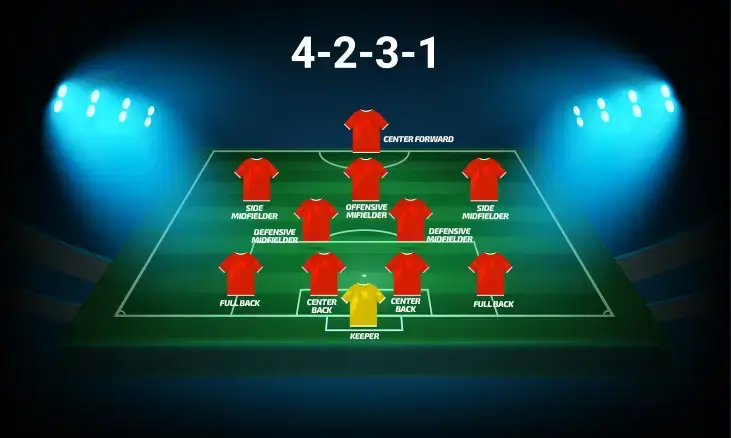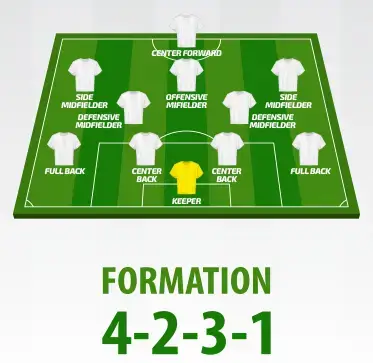CRFC BLOGS
LATEST BLOGS & NEWSLETTERS
Understanding of Youth Soccer 4-2-3-1 Formation
Choosing the proper formation in youth soccer can significantly affect how a team plays and how well players develop their skills. One of the most famous formations coaches use today is the 4-2-3-1 formation. Known for its balance between defense and attack, this formation is a great way to help young players learn the game, understand their roles, and work together as a team.
The Youth Soccer 4-2-3-1 Formation
The 4-2-3-1 formation involves four defenders, two defensive midfielders, three attacking midfielders, and one striker. It is designed to provide a solid defensive foundation while offering plenty of attacking play opportunities.
Four Defenders
The backline consists of two center-backs and two full-backs. The center-backs are responsible for marking the opposition’s forwards and preventing them from getting scoring opportunities. The full-backs, on the other hand, play a dual role. They must defend against wingers and support the attack by providing width and delivering crosses into the box.
Two Defensive Midfielders
These players sit in front of the defense and act as a shield. Their primary job is to break up opposition attacks before they reach the backline. They also play a crucial role in transitioning the ball from defense to attack, often acting as the first pass out of the defensive zone.
Three Attacking Midfielders
This group includes two wingers and one central attacking midfielder. The wingers stay wide, stretching the opponent’s defense and creating space for other players. The central attacking midfielder links the midfield with the striker and creates goal-scoring opportunities.
One Striker
The one forward is the main goal-scoring threat. This player must be able to hold up the ball, bring others into play, and finish chances when they arise.
Why the 4-2-3-1 Formation is Popular in Youth Soccer
Many youth coaches favor the 4-2-3-1 formation because it teaches players the importance of teamwork, positioning, and tactical discipline. It is a versatile formation that can be adjusted depending on the players’ strengths and weaknesses.
Strengths of the 4-2-3-1 Formation
Defensive Solidity
One of the key strengths of the 4-2-3-1 formation is its defensive stability. With two defensive midfielders protecting the back four, it becomes difficult for the opposition to penetrate the middle of the field. This setup allows the full-backs to push forward without exposing the defense, as the defensive midfielders can cover for them.
Attacking Flexibility
The 4-2-3-1 formation provides numerous attacking options. The three advanced midfielders can move fluidly, creating overlaps, underlaps, and crossing opportunities. The wingers can cut inside to shoot or stay wide to cross, while the central attacking midfielder can exploit spaces between the lines of the opposition’s defense. This formation encourages creativity and movement, making it harder for opponents to defend against.
Positional Versatility
Players in the 4-2-3-1 formation can move and adapt their positions based on the game’s flow. This versatility allows the team to switch tactics mid-game without changing the formation, making it one of the best formations in soccer for teams that want to be unpredictable and dynamic.

Weaknesses of the 4-2-3-1 Formation
However, the 4-2-3-1 formation has its weaknesses. Understanding these 4-2-3-1 formation weaknesses is crucial for coaches and players to address potential challenges on the field.
Vulnerability to Counter-Attacks
One of the most significant disadvantages of the 4-2-3-1 formation in soccer is its vulnerability to quick counter-attacks. If the full-backs push too far forward, the team can be exposed to fast breaks, especially if the defensive midfielders are caught out of position.
Dependence on Defensive Midfielders
The success of the 4-2-3-1 formation heavily relies on the defensive midfielders. If they are disciplined or are bypassed by the opponent, the defense can be protected. This can be a significant issue if the team faces a strong attacking opponent.
Striker Isolation
The one striker in the 4-2-3-1 formation can sometimes become isolated if the team is unable to maintain possession or if the midfielders do not adequately support the striker. This can lead to a lack of goal-scoring opportunities and put additional pressure on the defense.
Defending in the 4-2-3-1 Formation
Defending in the 4-2-3-1 formation is about maintaining a compact shape and using the defensive midfielders to protect the back four. The team should work together to close down spaces and force the opposition to play in less dangerous field areas.
Compact Shape and Pressing Strategy
A key aspect of 4-2-3-1 formation defending is the compact shape that the team must maintain. The defensive midfielders and the back four should move as a unit, staying close together to prevent gaps the opposition can exploit. The pressing strategy in this formation involves the advanced midfielders and striker working together to press the opposition high up the field, disrupting their build-up play and forcing turnovers.
Transition Defense
When the team loses possession, it is crucial to transition quickly from attack to defense. The 4-2-3-1 formation requires the advanced midfielders to quickly drop back to support the defensive midfielders and close any potential counter-attacks. This rapid transition is essential to prevent the opposition from exploiting the spaces left behind by the attacking players.

Soccer Drills for the 4-2-3-1 Formation
To effectively implement the 4-2-3-1 formation, coaches must use specific soccer drills to help players understand their roles and responsibilities. Here are some drills that can be particularly useful:
Defensive Drills
Defensive drills for the 4-2-3-1 formation should improve the coordination between the back four and the defensive midfielders. These drills can include:
4v4 Defensive Shape
Set up two teams of four players, one defending and the other attacking. The defending team should practice maintaining a compact shape and shifting as a unit to block passing lanes and force the attackers wide.
Defensive Transitions
Start with a small-sided game where the defending team must quickly transition from defense to attack and vice versa. This drill helps players practice the quick transitions required in the 4-2-3-1 formation.
Midfield Transition Drills
Midfield transition drills should emphasize quick passing and movement to help the midfielders transition from defense to attack. Some effective drills include:
Rondo Drills
A classic rondo drill involves players trying to maintain possession in a tight space while a smaller group tries to win the ball. This drill helps midfielders improve their quick passing, decision-making, and movement off the ball.
3v2 Transition
Set up a drill where three attacking players try to break down two defenders. Once the defenders win the ball, they quickly transition to attack, with the former attackers now defending. This drill emphasizes quick transitions and decision-making in tight spaces.
Attacking Drills
Attacking drills in the 4-2-3-1 formation should focus on building chemistry between the attacking midfielder, wingers, and striker. Useful drills include:
Crossing and Finishing
Practice crossing drills where the wingers deliver crosses into the box for the striker and attacking midfielder to finish. This drill helps players work on timing, positioning, and finishing under pressure.
Combination Play
Set up a drill in which the attacking midfielder combines with the wingers and striker to create goal-scoring opportunities. This drill encourages creativity and understanding among the attacking players.

Comparing the 4-2-3-1 Formation with the 4-3-2-1 Youth Soccer Formation
When comparing the 4-2-3-1 formation with the 4-3-2-1 youth soccer formation, it’s essential to consider the differences in midfield setup and attacking support.
4-2-3-1 Formation
The 4-2-3-1 formation offers more attacking flexibility with three advanced midfielders and a lone striker. This more balanced formation provides a solid defensive base while still allowing for creativity in attack. It encourages fluid movement and quick transitions, making it ideal for teams that want to play an aggressive, high-tempo game.
4-3-2-1 Formation
The Youth Soccer 4-3-2-1 formation emphasizes a solid midfield trio, with two attacking midfielders supporting the lone striker. This formation is more defensive-minded than the 4-2-3-1 and is often used when a team wants to control the midfield and minimize risks. It is particularly effective when a team wants to dominate possession and limit the opponent’s attacking opportunities.
Which Formation is Better for Youth Soccer?
The choice between the 4-2-3-1 formation and the 4-3-2-1 formation often depends on the players’ strengths and the coach’s desired style of play. The 4-2-3-1 formation might be more suitable for teams with dynamic wingers and a strong lone striker, while the 4-3-2-1 could be better for teams with a strong central midfield.
Both formations can be effective in youth soccer, but the 4-2-3-1 formation is often preferred because it provides a good balance between defense and attack, helping young players develop their skills in all areas of the game.

Conclusion
The 4-2-3-1 formation is one of the best in soccer, particularly for youth teams. Its balance between defensive solidity and attacking flexibility makes it ideal for teaching young players the fundamentals of soccer, and its strengths make it a favorite among coaches.
Join our Upcoming Seasons and Camps to learn and practice youth soccer formations.
FAQs
What is the 4-2-3-1 formation in soccer?
The 4-2-3-1 formation is a famous soccer setup with four defenders, two defensive midfielders, three attacking midfielders, and one striker. It’s known for balancing strong defense and flexible attacking options, making it ideal for youth teams.
Why is the 4-2-3-1 formation effective in youth soccer?
The 4-2-3-1 formation is effective because it provides defensive stability while encouraging creativity in attack. It helps young players learn their roles on the field and promotes teamwork by requiring coordinated play.
What are the strengths of the 4-2-3-1 formation?
The strengths of the 4-2-3-1 formation include its solid defensive structure, versatility in attack, and adaptability to different game situations. This formation helps teams control both the defensive and offensive phases of play.
How do you defend in a 4-2-3-1 formation?
Defending in a 4-2-3-1 formation involves maintaining a compact shape and using the two defensive midfielders to shield the back four. The team must work together to close down spaces and prevent the opposition from breaking through.
How does the 4-2-3-1 formation compare to other soccer formations?
The 4-2-3-1 formation is often compared to the 4-3-2-1 formation, with the former offering more attacking flexibility and the latter focusing more on midfield control. The choice between formations depends on your team’s strengths and tactical goals.

Did you find this useful?


